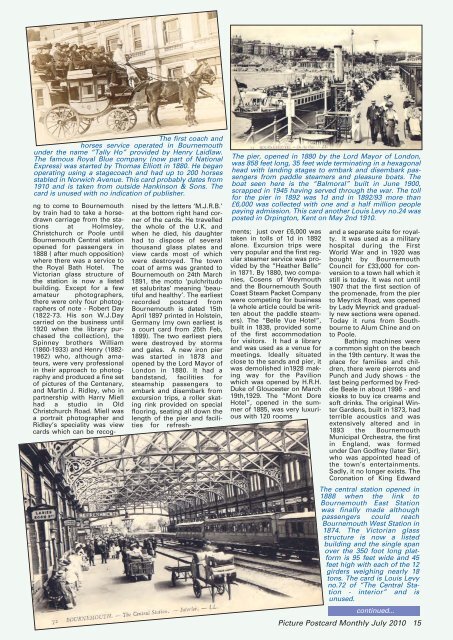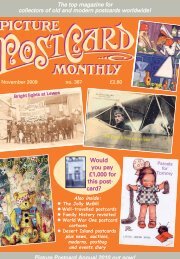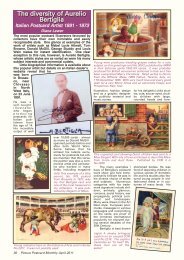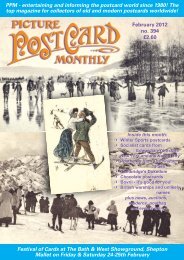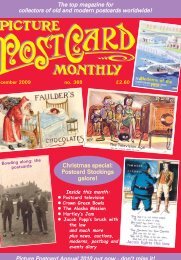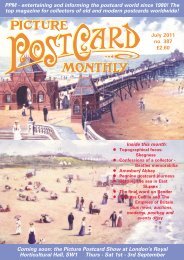PPM revisits Manchester's Belle Vue amusement park - Picture ...
PPM revisits Manchester's Belle Vue amusement park - Picture ...
PPM revisits Manchester's Belle Vue amusement park - Picture ...
Create successful ePaper yourself
Turn your PDF publications into a flip-book with our unique Google optimized e-Paper software.
The first coach and<br />
horses service operated in Bournemouth<br />
under the name “Tally Ho” provided by Henry Laidlaw.<br />
The famous Royal Blue company (now part of National<br />
Express) was started by Thomas Elliott in 1880. He began<br />
operating using a stagecoach and had up to 200 horses<br />
stabled in Norwich Avenue. This card probably dates from<br />
1910 and is taken from outside Hankinson & Sons. The<br />
card is unused with no indication of publisher.<br />
The pier, opened in 1880 by the Lord Mayor of London,<br />
was 858 feet long, 35 feet wide terminating in a hexagonal<br />
head with landing stages to embark and disembark passengers<br />
from paddle steamers and pleasure boats. The<br />
boat seen here is the “Balmoral” built in June 1900,<br />
scrapped in 1945 having served through the war. The toll<br />
for the pier in 1892 was 1d and in 1892/93 more than<br />
£6,000 was collected with one and a half million people<br />
paying admission. This card another Louis Levy no.24 was<br />
posted in Orpington, Kent on May 2nd 1910.<br />
ng to come to Bournemouth<br />
by train had to take a horsedrawn<br />
carriage from the stations<br />
at Holmsley,<br />
Christchurch or Poole until<br />
Bournemouth Central station<br />
opened for passengers in<br />
1888 ( after much opposition)<br />
where there was a service to<br />
the Royal Bath Hotel. The<br />
Victorian glass structure of<br />
the station is now a listed<br />
building. Except for a few<br />
amateur photographers,<br />
there were only four photographers<br />
of note - Robert Day<br />
(1822-73. His son W.J.Day<br />
carried on the business until<br />
1920 when the library purchased<br />
the collection), the<br />
Spinney brothers William<br />
(1860-1933) and Henry (1882-<br />
1962) who, although amateurs,<br />
were very professional<br />
in their approach to photography<br />
and produced a fine set<br />
of pictures of the Centenary,<br />
and Martin J. Ridley, who in<br />
partnership with Harry Miell<br />
had a studio in Old<br />
Christchurch Road. Miell was<br />
a portrait photographer and<br />
Ridley’s speciality was view<br />
cards which can be recognised<br />
by the letters ‘M.J.R.B.’<br />
at the bottom right hand corner<br />
of the cards. He travelled<br />
the whole of the U.K. and<br />
when he died, his daughter<br />
had to dispose of several<br />
thousand glass plates and<br />
view cards most of which<br />
were destroyed. The town<br />
coat of arms was granted to<br />
Bournemouth on 24th March<br />
1891, the motto ‘pulchritudo<br />
et salubritas’ meaning ‘beautiful<br />
and healthy’. The earliest<br />
recorded postcard from<br />
Bournemouth is dated 15th<br />
April 1897 printed in Holstein,<br />
Germany (my own earliest is<br />
a court card from 25th Feb,<br />
1899). The two earliest piers<br />
were destroyed by storms<br />
and gales. A new iron pier<br />
was started in 1878 and<br />
opened by the Lord Mayor of<br />
London in 1880. It had a<br />
bandstand, facilities for<br />
steamship passengers to<br />
embark and disembark from<br />
excursion trips, a roller skating<br />
rink provided on special<br />
flooring, seating all down the<br />
length of the pier and facilities<br />
for refreshments;<br />
just over £6,000 was<br />
taken in tolls of 1d in 1892<br />
alone. Excursion trips were<br />
very popular and the first regular<br />
steamer service was provided<br />
by the “Heather <strong>Belle</strong>”<br />
in 1871. By 1880, two companies,<br />
Cosens of Weymouth<br />
and the Bournemouth South<br />
Coast Steam Packet Company<br />
were competing for business<br />
(a whole article could be written<br />
about the paddle steamers).<br />
The “<strong>Belle</strong> <strong>Vue</strong> Hotel”,<br />
built in 1838, provided some<br />
of the first accommodation<br />
for visitors. It had a library<br />
and was used as a venue for<br />
meetings. Ideally situated<br />
close to the sands and pier, it<br />
was demolished in1928 making<br />
way for the Pavilion<br />
which was opened by H.R.H.<br />
Duke of Gloucester on March<br />
19th,1929. The “Mont Dore<br />
Hotel”, opened in the summer<br />
of 1885, was very luxurious<br />
with 120 rooms<br />
and a separate suite for royalty.<br />
It was used as a military<br />
hospital during the First<br />
World War and in 1920 was<br />
bought by Bournemouth<br />
Council for £33,000 for conversion<br />
to a town hall which it<br />
still is today. It was not until<br />
1907 that the first section of<br />
the promenade, from the pier<br />
to Meyrick Road, was opened<br />
by Lady Meyrick and gradually<br />
new sections were opened.<br />
Today it runs from Southbourne<br />
to Alum Chine and on<br />
to Poole.<br />
Bathing machines were<br />
a common sight on the beach<br />
in the 19th century. It was the<br />
place for families and children,<br />
there were pierrots and<br />
Punch and Judy shows - the<br />
last being performed by Freddie<br />
Beale in about 1996 - and<br />
kiosks to buy ice creams and<br />
soft drinks. The original Winter<br />
Gardens, built in 1873, had<br />
terrible acoustics and was<br />
extensively altered and in<br />
1893 the Bournemouth<br />
Municipal Orchestra, the first<br />
in England, was formed<br />
under Dan Godfrey (later Sir),<br />
who was appointed head of<br />
the town’s entertainments.<br />
Sadly, it no longer exists. The<br />
Coronation of King Edward<br />
The central station opened in<br />
1888 when the link to<br />
Bournemouth East Station<br />
was finally made although<br />
passengers could reach<br />
Bournemouth West Station in<br />
1874. The Victorian glass<br />
structure is now a listed<br />
building and the single span<br />
over the 350 foot long platform<br />
is 95 feet wide and 45<br />
feet high with each of the 12<br />
girders weighing nearly 18<br />
tons. The card is Louis Levy<br />
no.72 of “The Central Station<br />
- interior” and is<br />
unused.<br />
continued...<br />
<strong>Picture</strong> Postcard Monthly July 2010 15


